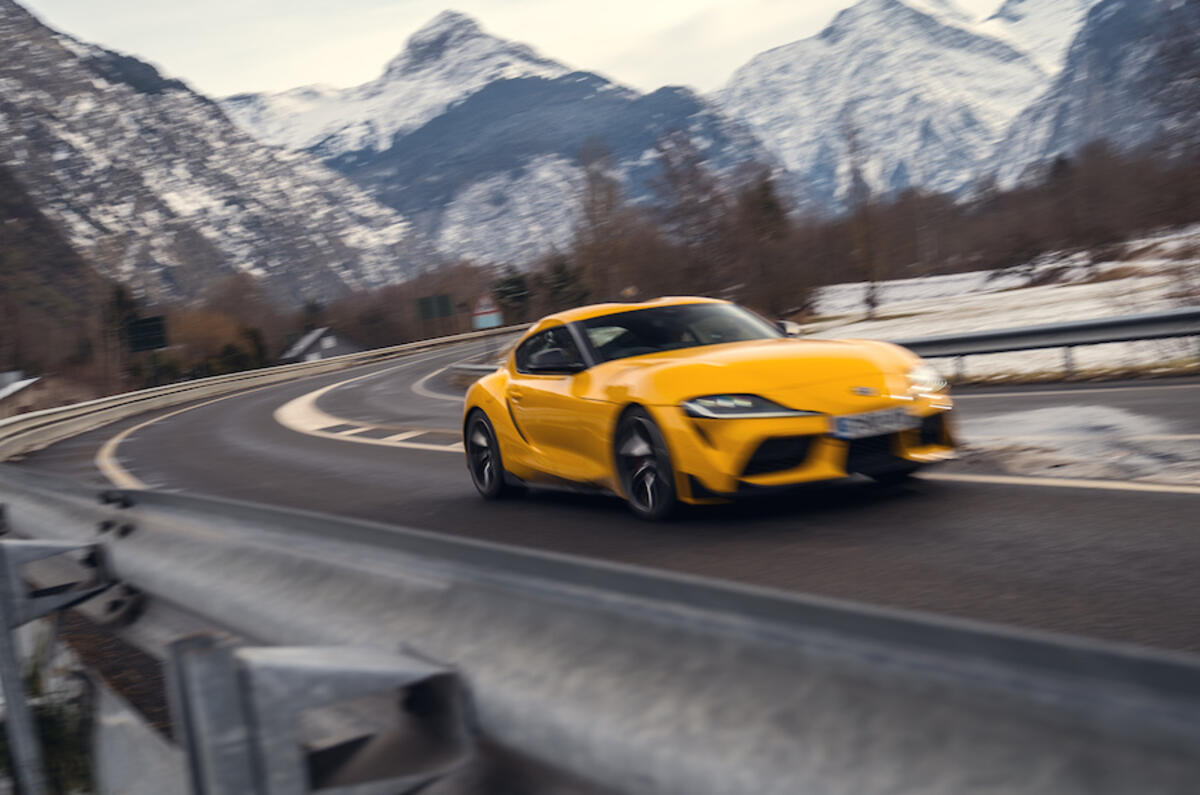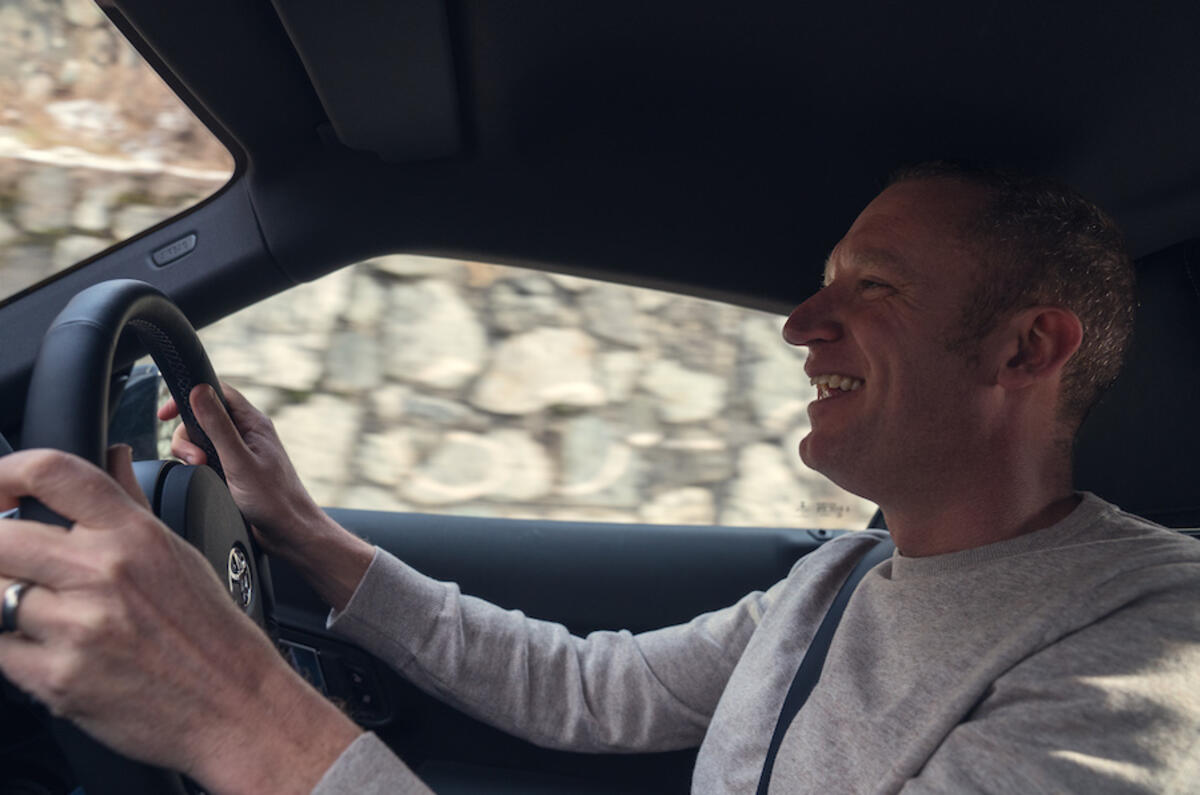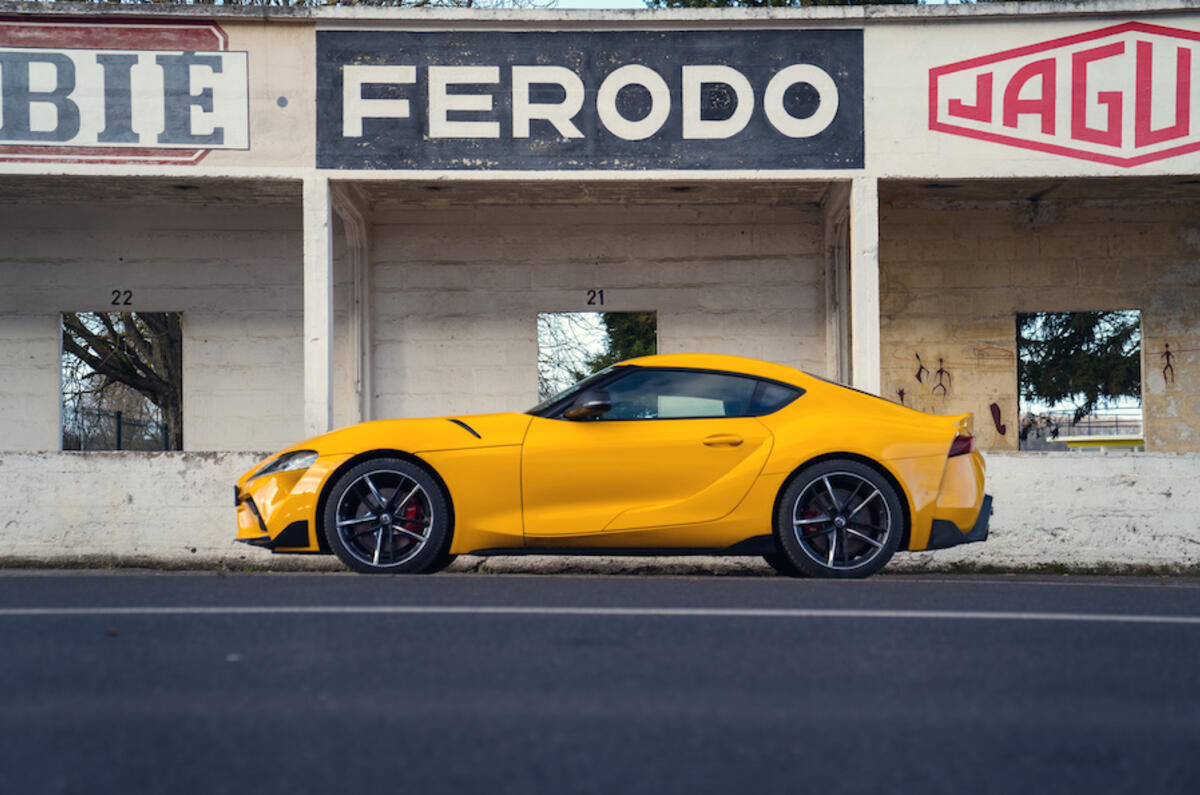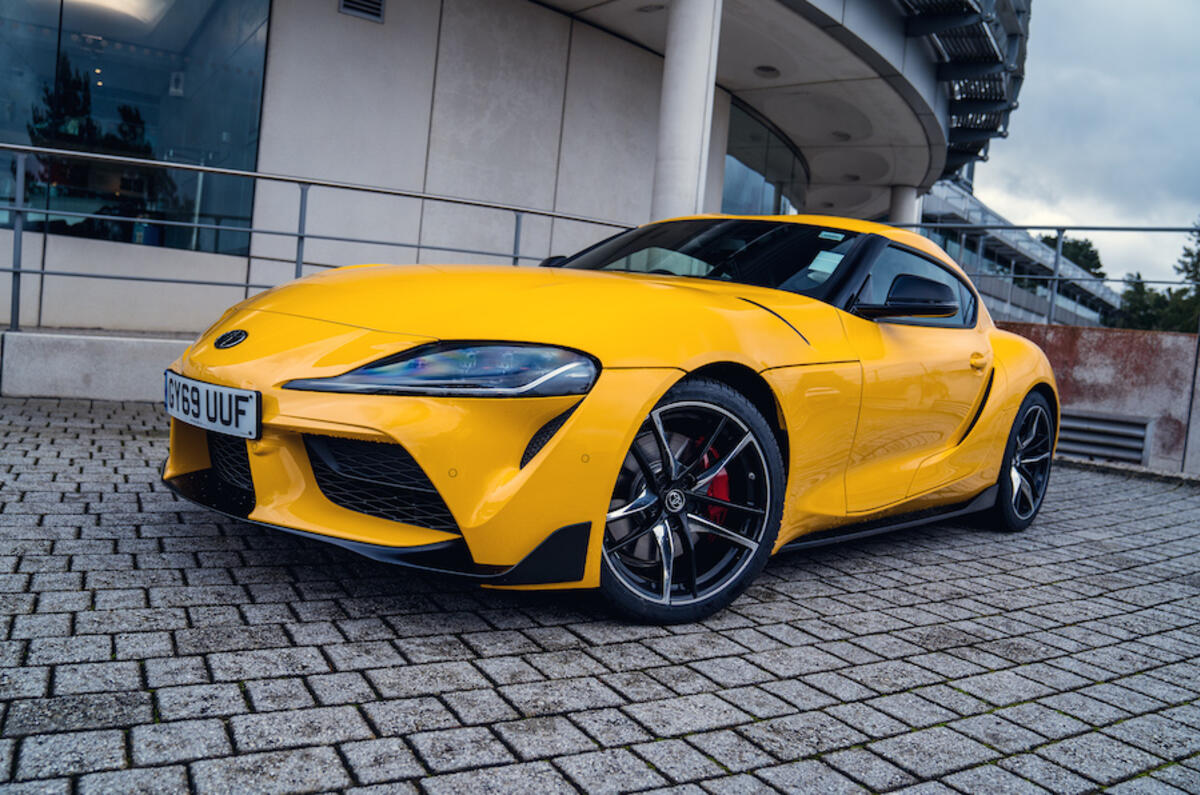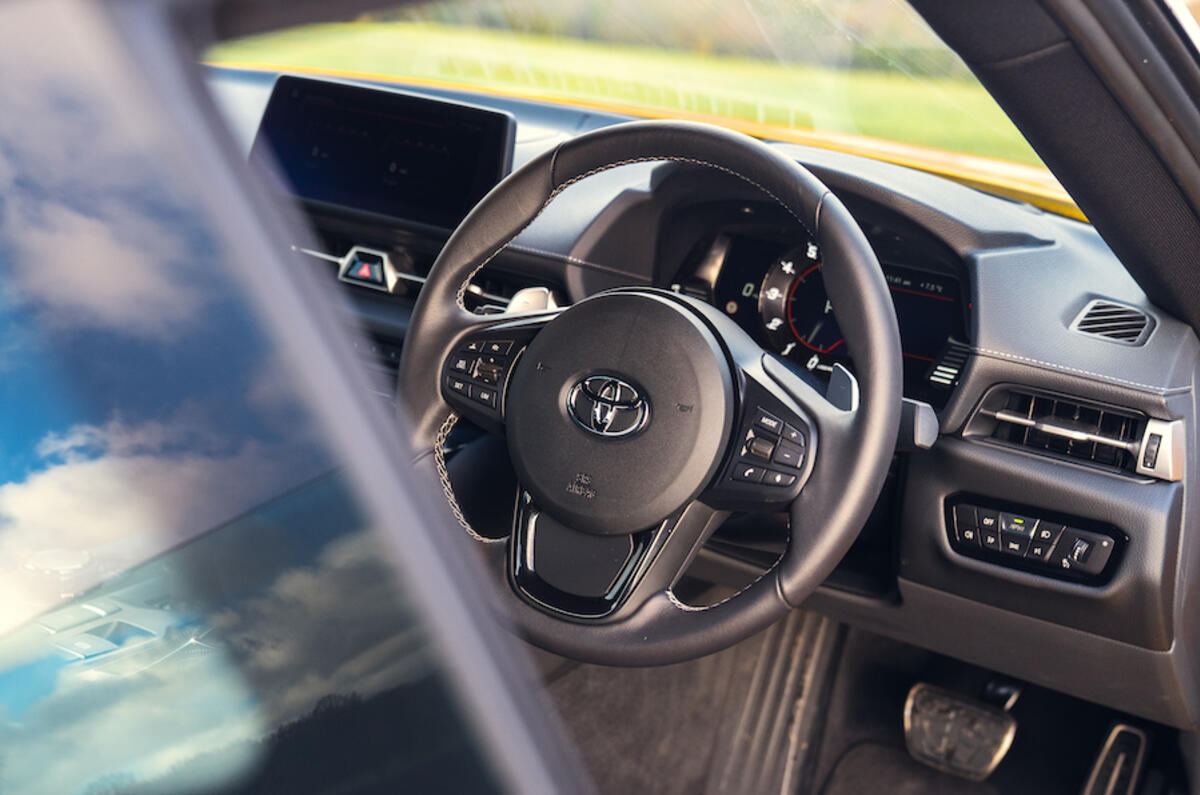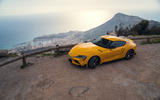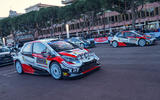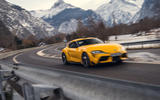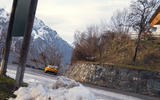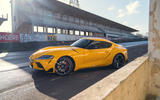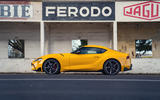Over the last three days, we've been driving the Toyota GR Toyota Supra across France to the World Rally Championship season-opening Rallye Monte Carlo, on a mission to learn all about this amazing sports car and the GAZOO Racing performance brand behind it.
On the way, we’ve visited the historic pitlane at Reims, conquered the twisty, snowy mountain passes of the Hautes-Alpes, gone behind-the-scenes with Toyota GAZOO Racing in the Rallye Monte Carlo service park, and set the style in the heart of glamorous Monaco for the start of the rally itself – all while covering hundreds of miles of French autoroute in between.
At every point of the journey, the Toyota GR Supra has been both an impressive and faithful companion. With former rally driver and World Rallycross commentator Andrew Coley at the wheel, we’ve proved it’s a true modern grand tourer – light, powerful, responsive and confidence-inspiring on tight and vertiginous Alpine roads; stylish, cosseting and practical on long journeys and in-town.
You can follow our trip below. Plus, we’ll shortly be posting a behind-the-scenes video of our journey – so make sure to watch out for that.
Learn more about the Toyota GR Supra at toyota.co.uk/supra
05:30 Tuesday 21st January
It’s a cold January morning, but a new dawn is breaking for Toyota. We’re in Dover, with the keys to the Toyota GR Supra in our hand – ready to drive across Europe to join Toyota GAZOO Racing at Rallye Monte Carlo.
As Toyota founder Kiichiro Toyoda once said: “To test the durability and performance of their cars, companies ought to participate in auto races. Such races must not be regarded as a simple matter of curiosity. They are indispensable.” So, the idea of driving the GR Supra across Europe to one of the world’s most iconic motorsport events feels like an indispensable way to satisfy our curiosity about Toyota’s new GAZOO Racing performance brand.
06:30 Tuesday 21st January
As we wait for our ferry, there’s time to admire the GR Supra. This dramatic fifth-gen re-imagining of Toyota’s sportscar icon is perfect for this trip. As a two-seat, front-engine, rear-wheel-drive ‘grand tourer’, it boasts the sort of style that turns heads on the autoroute and the Riviera, as well as handling and power that thrill on winding Alpine roads. Inside, there’s room for a weekend’s luggage, behind a two-seat cabin that is as cossetting on long journeys as it is driver-focused on the twisty bits.
On the outside, the GR Supra offers a powerful modern take on classically pure sportscar style. Its low-slung profile – the long bonnet that masks a powerful straight-six 3.0-litre turbo blending into a pushed-back two-seat cabin with a double-bubble roof – is pure 2000GT. (Yes, that's the iconic 1960s sportscar that Toyota had to chop the top off in order to fit the daunting 6ft2in Sean Connery in You Only Live Twice).
The distinctive front grille evokes classic Supra styling, while the muscular haunches that frame the imposing 19” forged alloy wheels blend into a sharp-edged rear. Not all of the design decisions were about aggressive modern looks or iconic nods to the past, though. Each and every curve of the GR Supra has been designed to boost aerodynamic performance, with the double-bubble roof minimising drag towards the large flick-up rear spoiler, while also creating more headroom inside. Clever stuff.
07:00 Tuesday 21st January
Joining us on our journey to learn more about Toyota GAZOO Racing is former rally driver turned World Rallycross commentator Andrew Coley, who will act as our guide and all-round guru behind the scenes at Rallye Monte Carlo. As we graze the breakfast buffet on the ferry, fuelling ourselves for the journey ahead, perhaps the most pertinent question is: “What is GAZOO Racing”.
Well, it all stems back to the early days of the internet and a Toyota e-commerce site for used cars – named gazoo.com, after the Japanese word for picture ‘gazo’. Toyota’s engineers picked up on this, using ‘Gazoo’ to describe all of the different and unique performance cars, each sitting in individual ‘garages’. The GAZOO Racing name stuck when Toyota was looking to brand its new performance arm, with GR and GR Sport used to designate race-bred, performance-tuned Toyotas.
10:00 Tuesday 21st January
After 100 miles of French Autoroute, it’s clear the Toyota GR Supra is the perfect companion for long journeys like this. The 3.0-litre straight six settles down nicely at motorway pace, with its 155mph top speed kept nicely in check thanks to Adaptive Cruise Control and Road Sign Assist. When we do need to pass the French lorries that linger on the inside lane, the twin-scroll turbo provides incredibly direct response from low rpm, delivering the Supra’s 500Nm of torque at an impressive rate.
The driver-focused cockpit (inspired by the cocoon of single-seater race cars) feels incredibly cosseting with its race-inspired leather sports seats – especially when the heated seats and dual-zone automatic air conditioning are cranked up to provide Mediterranean levels of warmth, compared to the cold January air outside. It seems almost a shame to open the windows for the péage toll booths.
The low, slim horizontal dashboard provides the perfect view of the road ahead, with the 8.8-inch high-definition digital dashboard, 8.8-inch central multimedia display and optional head-up display giving us access to all the information we need – whether it’s navigation, a quick phone call to the rest of the crew in our follow car, or a bit of Serge Gainsbourg on the 12-speaker JBL premium sound system.
“The Supra absolutely looks and sounds the part,” says Andrew. “I particularly love the rear profile – whether you’re outside the car, or in it. The rear haunches just sit wonderfully in the rear-view mirror. It’s a hard balance to create a true performance car that is comfortable, easy to drive and not too noisy on a long road trip. But, the Supra feels really easy to drive and refined. And, when you put your foot down, it sounds like a sportscar and reacts like a sportscar. It feels like a real grand tourer.”
11:30 Tuesday 21st January
No trip across France is complete without stopping at the iconic Reims pitlane. Based on a triangle of public roads off the D27 autoroute, this former home to the French Grand Prix and the Reims 12 Hours sportscar race was last used in 1969. But even though the only engine notes today are the rumble of trucks ferrying goods around Europe, you can still feel the echoes of racing legends from the past as you explore the abandoned concrete grandstands.
Due to its location in the heart of Europe, Reims is the crossroads of European motorsport – especially when it comes to Toyota’s modern racing history.
Head 220 miles west from Reims and you reach Le Mans, home to motorsport’s toughest and perhaps most iconic test. Run on the 8.8-mile Circuit de la Sarthe (using public autoroutes closed for the event), the Le Mans 24 Hours challenges teams to race twice round the clock through day, night and rain, clocking up speeds of 200mph on the fearsome Mulsanne straight in advanced prototype sportscars.
Toyota has been the dominant force at Le Mans in recent years, its advanced TS050 hybrid prototype taking back-to-back victories in 2018 and 2019, while also setting record-breaking laps that will probably stand for years to come.
Head 220 miles east of Reims into Germany, and you reach the Nürburgring. Known as ‘The Green Hell’, the Nürburgring’s 13-mile Nordschleife loop is perhaps even more extreme than Le Mans, with 170 challenging corners and 1,000 feet of swooping elevation change making it more like a Welsh B-road than a race track.
The Toyota GR Supra is the latest in a long-list of Toyota performance cars to be tested to the limit at the Nürburgring, with the production GR Supra’s handling and high-speed endurance honed over hundreds of laps of the Nordschleife, before a race-prepped Toyota GR Supra made a successful debut in the gruelling Nurburgring 24 Hours in 2019, finishing third in class.
We’re heading south, though, to Rallye Monte Carlo an event in which Toyota has an equally enviable record for success. As we drive the Toyota GR Supra towards Dijon, we can feel every ounce of that sportscar and rallying heritage in the car.
15:00 Tuesday 21st January
Buoyed by Reims, we spend the next leg reminiscing about Toyota’s iconic racing heritage. Toyota built its motorsport reputation in Japan in the 1960s with the 2000 GT and Toyota 7, while the iconic Celica, Supra and MR2 that raced in Japanese Super GT became famous in the 1990s through the Gran Turismo videogames.
The lure of competing in Europe’s biggest and toughest sportscar races proved irresistible, though. Toyota first raced at Le Mans in the 1980s and 1990s, supplying engines for the Dome and TOM’s Group C cars, before narrowly missing out on a win in 1999 with its Toyota GT-One. After a decade in Formula 1, Toyota returned to Le Mans in 2012 – using the World Endurance Championship’s gruelling races to hone its pioneering hybrid technology on its way to the 2014 manufacturers’ title.
In 2018 and 2019, Toyota GAZOO Racing’s advanced TS050 hybrid finally took back-to-back wins at Le Mans, setting record-breaking laps that will stand for years to come. Now, Toyota GAZOO Racing is preparing for a new generation of Hypercar rules, with a race-honed version of its GR Super Sport hybrid concept.
The Nürburgring 24 Hours offers a very different challenge for GAZOO Racing. Held on a 15.7-mile blend of the Formula 1 track and the Nordschleife loop, it’s a world from the wide long flat-out blast of Le Mans – feeling more like a narrow, tortuous winding mountain pass, or a patchwork ribbon of the world’s best driving roads.
There’s also a more eclectic mix of cars and drivers to compete against – ranging from factory-backed GT3 sportscars, to privateers with race-honed hatchbacks – while the dramatically changeable weather of the Eiffel mountains has thrown up race-halting snow and sleet, even in May.
Toyota’s late great master test driver Hiromu Naruse – one of the founding fathers of GAZOO Racing – first raced a Toyota Celica 1600 GT at the Nürburgring in the 1970s and saw the track as the ultimate proving ground. “On the wonderful surfaces of Japanese circuits, it was only possible to understand one-tenth of a car,” he said. “The Nürburgring let us see everything. It made it impossible to deceive ourselves.”
Toyota’s approach to the Nürburgring 24 Hours is very different to its rivals. Rather than going for the glory of outright victory, Toyota runs modified production cars, pooling road car engineers from its global vehicle development teams to get hands-on experience of road car development in the white-hot heat of competition.
Toyota President Akio Toyoda also joins the team, racing the cars under the pseudonym Morizo Kinoshita. “At the Nürburgring, I feel we are less of a works team and more of a Toyota privateer team,” says Toyoda.
In 2007, the newly formed GAZOO Racing squad entered the Nürburgring 24 Hours and has since racked up thousands of miles of racing knowledge with the Lexus LFA, Toyota GT86 and Lexus RC – all of which went into developing the Toyota GR Supra. The production Supra’s handling and high-speed endurance was then honed over hundreds of laps of the Nordschleife, before a race-prepped Toyota GR Supra made a successful debut in the 2019 Nürburgring 24 Hours, finishing third in class.
19:00 Tuesday 21st January
The Toyota GR Supra has eaten up another 200 miles of French autoroute, and we’re finally pulling into Dijon for our overnight halt. The car looks simply stunning in this historic city, and we notice plenty of turned heads as we pull into our hotel.
As in most European cities, the car parks of Dijon are best described as ‘a bit tight’. But the Toyota GR Supra’s slender dimensions – allied to intelligent parking sensors and a rear-view camera – ensure that we negotiate the dark labyrinthine depths of the underground bunker with few worries.
After dining on some creamy tartiflette and picking up a couple of the jam-filled nonnette gingerbread cakes from Dijon’s historic market streets to provide sticky sustenance on the next leg of our journey, it’s time to turn in.
Tomorrow we hit the French Alps, where the Toyota GR Supra really promises to come into its own, before we join the Toyota GAZOO Racing World Rally Team in the heart of the French town of Gap.
08:00 Wednesday 22nd January
After a hearty breakfast, it’s time for the next leg of our journey, heading south to the small French town of Gap – home to the Toyota GAZOO Racing World Rally Team for the Rallye Monte Carlo weekend. The convenience of keyless entry means we’re soon powering away from Dijon, the Toyota GR Supra’s adaptive LED headlights carving our path through the early-morning gloom.
Rather than taking the autoroute directly to Gap, we’re following the D1091 round the north-east of the Hautes Alpes range. Local knowledge pays a dividend when one of the experienced skiers in our crew spots that we’re passing the resort of Alpe d’Huez, with an access road that snakes its way 1,860m up the to the resort.
This mountain pass – a regular stop on the Tour de France since 1952 – boasts 21 hairpin bends, and a gradient that averages 8.1% and peaks at 13%. As a ski resort access road it’s nice and wide, but the vibe is pure Rallye Monte Carlo – drystone cliff wall on one side of the road, and concrete barriers that provide scant protection from a vertiginous cliff drop on the other. In the middle, there’s a snaking ribbon of asphalt with twists, kinks and hairpins that truly let the GR Supra shine.
09:00 Wednesday 23rd January
On twisty Alpine passes like this, the Toyota GR Supra really comes alive. The 335bhp and 500Nm from the turbocharged 3.0-litre straight-six is perfectly balanced with the lightweight chassis, while the single twin-scroll turbo delivers impressively direct response from lower revs – helping us punch our way out of tight hairpins and conquer steep inclines without ever feeling breathless.
Flicking through the eight-speed automatic’s short-ratio lower gears, the GR Supra’s ability to sprint from one bend to the next is truly impressive. Responsive Brembo aluminium brakes – four-piston 384mm x 36mm ventilated discs at the front, 345mm x 24mm at the rear – easily bleed that pace off for the next bend. The GR Supra’s electronic aids add extra confidence, without getting in the way: the Active Differential nicely balancing the power through the rear tyres, while Active Cornering Assist applies light brake pressure to each corner of the car to fine-tune the handling.
As we get higher, the road only gets steeper, twistier and more fun, highlighting the GR Supra’s cleverly considered underpinnings. Toyota’s engineers took great effort to place the Supra’s engine further back in the chassis for optimum 50:50 weight distribution, while the Supra’s wheelbase (2,740mm) and track width (1,589mm) have been honed to match the golden 1.55 ratio for a sportscar of this size.
The GR Supra’s chassis is also more rigid than that of the Lexus LFA supercar, with a centre of gravity lower than the Toyota GT86 coupe. That’s a better base for the race-inspired suspension – double-joint spring MacPherson struts up-front, and five-link at the rear, with rigid lightweight aluminium components that reduce the Supra’s unsprung weight.
Adaptive Variable Suspension delivers the final polish, actively adapting the damping response at each wheel to improve both handling and ride comfort. That’s perfect on Alpine roads like these, which start smooth but are battered and potholed by ice and snow every year on the higher turns.
“I’m seriously impressed,” says World Rallycross commentator Andrew Coley, who has joined us for the trip to Monte Carlo, and is now using every ounce of his rally driving experience to revel in the GR Supra’s performance. “The handling is incredibly accurate – really pointy and directional, but also inspiring confidence – while the engine has plenty of torque.
"The manual mode for the gearbox is great. It’s good enough in auto, but out of the hairpins you really want to choose the gear you want – either for more punch, or to control the revs when the conditions get more slippery. All that makes this car perfect for a relentlessly steep and twisty mountain road like this. You never feel like you’re left wanting more.”
10:00 Wednesday 22nd January
At the top of the pass, we grab a coffee and reflect on how the Toyota GR Supra has performed. There are lots of little touches in the driver-focused cabin that enhance the experience. The race-inspired leather sports seats feel incredibly cocooning, like you’re in a race car. All the controls fall easily to hand, while the low slim horizontal dashboard works with the head-up display and 8.8-inch high-def digital dashboard to give you a clearer view of both the road ahead, as well as key driving data.
The Supra also features two clever bits of technology that give extra confidence on roads like this – a brake drying function that applies a tiny bit of brake pressure when the wipers are going to keep the discs dry, and automatic fade prevention which applies extra pressure when the discs get hot to avoid a drop-off in performance.
With dark clouds on the horizon and the feel of icy rain in the air, both features should come in handy on the descent down the other side of the pass.
12:00 Wednesday 22nd January
The small town of Gap sits in the heart of the Hautes Alpes. With the Rallye Monte Carlo route threading its way through the tight, twisty mountain passes that weave through the peaks and valleys of the region, it’s the perfect base for the World Rally Championship teams for the weekend ahead.
The service park is a bustle of activity. When the aggressive-looking World Rally Cars aren’t being fettled in the teams’ awnings, they’re being driven to the scrutineering bay to check their legality for the rally ahead. Drivers and engineers are locked deep in discussion about gear ratios and damper settings as they return from recceing the stages and preparing their pace notes. It’s all to a soundtrack of spanners, hammers and pneumatic tools hitting raw metal as the cars are fettled for the challenge ahead.
Toyota has built an impressive record in the WRC since its debut in 1973, scoring four drivers’ titles and three manufacturers’ titles in the 1990s with two-times champion Carlos Sainz, four-times champion Juha Kankkunen and 1994 champion Didier Auriol driving the Toyota Celica and Corolla.
Since returning to the WRC in 2017, the Toyota GAZOO Racing World Rally Team – run by four-times drivers’ title-winning legend Tommi Makinen – has set new benchmarks for success with the Toyota Yaris WRC, winning the manufacturers’ title in 2018 and the drivers’ title in 2019 with Ott Tanak.
For 2020, the Toyota GAZOO Racing World Rally Team has signed up six-times champion Sebastien Ogier as lead driver, alongside rising star Elfyn Evans (son of rally ace Gwyndaf Evans) and up-and-coming 19-year-old Kalle Rovanpera.
Toyota GAZOO Racing team principal Tommi Makinen is convinced he’s pulled together the right blend of experience and consistency, combined with youthful speed and spirit, in order to keep the Toyota GAZOO Racing World Rally Team at the sharp end of the WRC pack in what is set to be a closely contested season.
“I’m really pleased with the driver line-up we’ve put together,” Makinen says. “We know how strong Sebastien is, and being able to attract a driver with his record says a lot about what we’ve achieved in a short space of time with Toyota. I’ve watched Elfyn for some time. He has the speed to win on almost any surface, but he’s also clever when needed and can score good points. I’ve known Kalle since he was young, and it has always been clear he has something special. He still has lots to learn, but he is ready for this step. This line-up provides us with a great balance.”
As Ogier – a hometown boy, hailing from Gap – is a six-times winner of the Rallye Monte Carlo, as well as being a six-times champion, the Toyota GAZOO Racing World Rally Team has high hopes for both the season ahead, and this event.
“Rallye Monte Carlo is always an exciting event at the start of a new season, and it should be especially interesting this year with so many drivers in new cars,” says Makinen. “We’ve yet to win this rally, but we’ve finished on the podium every time. Sebastien’s record here is brilliant and he’s won it in many different cars – so I’m sure he’ll be in the fight again, even though he will still be getting to know our car. It will be similar for Elfyn, who has shown good speed on the Monte before.”
14:00 Wednesday 22nd January
In a moment of quiet, we duck our heads under Toyota’s awning to take a closer look at the Toyota Yaris WRC. Built to the WRC’s new rules – creating more powerful cars that are more challenging to drive, and more spectacular to watch – it’s an impressive-looking beast.
You can see the familiar shape of the Yaris, but the aggressive flared-out fenders, sharp winglets and huge rear wing make it look like it’s going 120mph, even when it’s standing still. Under the bonnet is a race-tuned 1.6-litre turbo engine that delivers an astonishing 380bhp and 425Nm of torque – all transmitted to the road through a six-speed hydraulic shift with a double-plate clutch, and an advanced four-wheel-drive with an active centre differential.
Under the gaping wheel arches are huge 370mm brakes and rugged suspension that can be tuned to the demands of the WRC’s diverse mix of roads – ranging from the snow and ice of the season-opening rallies in Monte Carlo and Sweden, through the rough rocky roads of Mexico and Argentina, the frighteningly fast-flowing loose gravel and huge jumps of Finland, and the slippery muddy gravel of Wales.
15:00 Wednesday 22nd January
The Toyota Yaris WRC has inspired the next performance road car to come out of GAZOO Racing’s stable – the Toyota GR Yaris. This pocket-sized, lightweight four-wheel-drive super-hatch will blend all of GAZOO Racing’s performance car knowledge with the unique experience of Tomi Makinen’s rally team.
Built on the same platform as the new Yaris, the GR Yaris has a sportier appearance thanks to a lowered roofline, a wider track, huge rally-inspired wheel arches and a model-unique three-door design. But, even with all the extra tweaks, Toyota wanted to keep a streamlined look for the GR Yaris – making it a subtle hot hatch wolf in more urbane sheep’s clothing, as well as reducing the overall weight of the car for improved handling and performance.
That philosophy of weight reduction extended to the GR Yaris’ underpinnings – all chosen for lightweight design as much as performance benefit. The compact 1.6-litre turbo three-cylinder has been tuned to offer 257bhp and 360Nm of low-down torque through a six-speed manual gearbox, while Toyota’s new GR-FOUR all-wheel-drive system with a high-performance rear coupling lets the driver pick the balance – 60:40 front-to-rear during Normal driving, 30:70 for Sport and 50:50 for Track.
“Our policy at GAZOO Racing has always been to use motorsports to refine our knowhow and personnel with the aim of launching world-class production sportscars,” said Shigeki Tomoyama, President of GAZOO Racing. “The GR Supra is a sportscar developed through track racing. The GR Yaris is born from the WRC.
“The WRC uses cars based on production cars, and rallies are extremely demanding events. If we intend to refine people and cars, using motorsport as a foundation for ‘ever-better cars”, then the WRC is the ultimate battlefield. The GR Yaris evolved into a ‘super hot hatch’ – a type of car that would previously have been unthinkable for Toyota. It will show our customers how enjoyable driving can be.”
Autocar’s road test team have already got behind the wheel of a development prototype and were very impressed by what they found. We can’t wait to see the final car in action.
16:00 Wednesday 22nd January
The shakedown is the Toyota GAZOO Racing World Rally Team’s last chance to give the Toyota Yaris WRC a high-speed run before the start of the Rallye Monte Carlo. It’s held on a small loop of closed public road, just outside Gap, and a throng of fans – fresh from the drivers’ autograph session – pack the embankments over the stage to get their first glimpse of the 2020 cars and drivers in action.
Until you see a World Rally Car in action, it’s impossible to understand how other-worldly their performance is. You feel the deafening rattle of revs from the Yaris WRC’s 1.6-litre turbo reverberating around your chest as Ogier engages launch control and floors the throttle on the start line, holding the 380bhp on a knife edge for what seems like an eternity.
When the car is finally waved off, the Yaris WRC practically leaps off the line – the four-wheel-drive hunting for every ounce of grip from the slippery and rough asphalt road as 425Nm of torque is unleashed. Approaching the first corner, you wonder whether Ogier has forgotten that it’s there. But, as the car darts sharply into the turn, you can only admire the grip that the Yaris WRC generates – and Ogier’s skill and commitment – as the car disappears round the bend, accompanied by a chorus of crackles and pops from the exhaust.
As darkness falls, we join the fans heading back to the hotels in Gap with a new-found admiration for Toyota GAZOO Racing performance – and the chance to enjoy it again with the Toyota GR Supra on the final leg of our journey to Monte Carlo.
08:00 Thursday 23rd January
It’s the final leg of our journey to the start of Rallye Monte Carlo, taking in the cruise from Gap to Monaco. Although the service park for the rally – and large portions of the route – are in the hills to the north of Monaco, the official rally start is in the iconic surroundings of the Principality.
After some final fettling of the Toyota Yaris WRC in Gap, the Toyota GAZOO Racing World Rally Team will be heading south to the Cote d’Azur for Rallye Monte Carlo’s opening ceremonies later today. We’re making an early start, though – eager to see how the Toyota GR Supra cuts the mustard in amongst the beautiful people.
On dark winter mornings like this, you really appreciate the benefit of the intelligent aids that make driving a premium modern sportscar so much easier and safer – both for you, and those around you. Pedestrian and cyclist detection offer an extra set of eyes when navigating busy town centres, while the blind spot monitor and lane departure alert give added confidence once we’re out on the autoroute.
09:00 Thursday 23rd January
As we settle into a nice cruising speed on the autoroute, talk turns to the new Toyota GR Supra GT4 – a race car based closely on the road-going GR Supra, which is making its competitive debut this year in the hands of privateer customer teams.
The road-going GR Supra’s chassis has been stripped out for lightness and made even safer and more rigid with a high-strength roll cage, while its 3.0-litre six-cylinder twin-scroll turbo engine has been tuned to deliver 420bhp, as well as enhanced reliability for long-distance endurance races such as the Nurburgring 24 Hours.
A carbon fibre front splitter and a huge rear wing offer extra aerodynamic grip, while race-honed KW dampers, powerful Brembo racing brakes and slick Pirelli race tyres provide greater grip and speed in the corners. At the rear, an Akrapovic exhaust gives the racing GR Supra GT4 an even more raucous mix of pops and bangs, even when compared to the throaty exhaust on the road-going GR Supra.
Former Le Mans winner Stephane Ortelli has done the bulk of the GR Supra GT4’s development work, but British Touring Car Championship driver Tom Ingram – who raced a Toyota Corolla for Team Toyota GB Speedworx Motorsport to sixth place in the 2019 standings – recently got behind the wheel at Jarama.
“When I saw the GR Supra GT4 for the first time, I fell in love with it,” Ingram said after testing it. “Compared to the Corolla I use in the BTCC, it was really interesting to see the difference. My Corolla is front-wheel-drive, 350bhp. The GR Supra GT4 is 420bhp, rear-wheel-drive, paddle-shift, ABS and traction control, so it was a totally different experience to get my head around – but one I really enjoyed. Toyota have not compromised or held back in any areas with this car.”
12:00 Thursday 23rd January
As we descend the twisty mountain roads into Monaco, skyscrapers fight for every inch of real estate between the hills that border the Principality and the Mediterranean, glistening azure blue into the distance. It’s a reminder – as if one were needed – that the only measure of success in Monaco is ‘up’.
A stylish two-seater like the Toyota GR Supra fits Monaco perfectly, though – the classic case of ‘less is more’. As we ease through the narrow streets, bustling with tourists and glamorous residents in the mild Mediterranean winter, we certainly don’t feel like interlopers among the huge luxo-limos and gold-painted hypercars.
The GR Supra’s dimensions are also very Euro-city-friendly, helping us thread our way through the tight streets and bustling crowds.
In fact, at every point of the journey, the GR Supra has turned heads – whether it was a family pulling over to join us at Reims in order to let their 12-year-old boy get a picture of the Supra, or the French passer-by at the base of the run to Alpe d’Huez who wouldn’t let us leave until he’d taken a look under the bonnet.
Casino Square – where the World Rally Championship teams are gathering for the start of Rallye Monte Carlo – is perhaps more synonymous with Formula 1.
Toyota first entered Formula 1 in 2002, operating from a purpose-built state-of-the-art facility in Cologne which continues to act as Toyota GAZOO Racing’s European HQ today. The Toyota F1 team proved a consistent front-runner and points-scorer during its eight years at the sport’s top level, with three pole positions and 17 podium finishes.
In fact, Toyota has a long history of success in single-seater racing – especially in the various international Formula 3 junior series, which breed the next generation of champions. It would be hard to list all the eventual champions who used Toyota power to start their careers in in Japanese, British and European F3 or the US-based Toyota Atlantic series, but suffice to say it includes Formula 1 legends such as Nelson Piquet, Ayrton Senna, Damon Hill and Jacques Villeneueve.
Toyota also has an impressive record in US IndyCar and NASCAR oval racing, winning the Indianapolis 500 in 2003 and the Daytona 500 in 2019.
14:00 Thursday 23rd January
There’s much more to Toyota’s rallying tale than just the WRC, and as we wait with the crowds in Casino Square for the cars to appear on Rallye Monte Carlo’s start ramp, talk turns to the recent Dakar Rally: a gruelling 10-day high-speed off-road marathon that, in recent years, crossed the vertiginous Andes mountains in South America.
For 2020’s new route in the deserts of Saudi Arabia, reigning champion Nasser Al-Attiyah was joined in Toyota’s four-strong line-up of Hilux Dakar rally-raid cars by Fernando Alonso – the Spaniard looking to boost his tally of motorsport’s blue riband wins alongside his two Formula 1 titles, his pair of Monaco Grand Prix wins, and his back-to-back Le Mans 24 Hours wins with Toyota GAZOO Racing.
In the end, Al-Attiyah finished a close second overall, while Alonso impressed on his Dakar Rally debut in what is one of the world’s toughest off-road events.
16:00 Thursday 23rd January
As the clock ticks down to the official start for Rallye Monte Carlo, the Toyota GAZOO Racing World Rally team gathers in the heart of Monaco's harbourfront district – right where the Formula 1 pitlane will be come May – to join the other teams crossing the start ramp.
Toyota GAZOO Racing’s all-new driver line-up – six-times WRC title winner Sebastien Ogier, British WRC star Elfyn Evans and Finnish youngster Kalle Rovanpera – are certainly looking forward to the task ahead.
Ogier – in particular – has every right to feel confident, albeit a bit nervous. A six-times world champion, and a six-times Rallye Monte Carlo winner (and the fastest driver in the pre-rally shakedown) he starts the event and the season as favourite, but still has so much to learn about his new team.
“I’m excited to start my first rally in the Toyota Yaris WRC,” he says. “So far, everything is good and running like we were hoping. Shakedown doesn’t mean much, but it’s always a good sign if you’re in the rhythm. Every car has different characteristics and it takes some kilometres to learn about them, but so far it has been good in testing.
“We want to fight for a seventh title this year, and I believe we have a good chance with this car. Rallye Monte Carlo also has special emotions for me. I remember coming to spectate at the end of the 1990s and Tommi was winning a lot – he was the first idol I had in rallying. I now have a strong record here, and every year there is more pressure to try and continue that. It’s always a big challenge, but one I definitely enjoy. But this is the one rally of the year you need to start humble.”
Evans is starting a new chapter in his career – and one that will hopefully help him add to his win in the 2017 Wales Rally GB. “It was a really nice feeling to get started with the Yaris, and I’m looking forward to my first event with Toyota,” the Welshman says. “It’s the first time in my WRC career I’ve changed teams, but everybody has been very welcoming, and in testing I was able to get a nice feeling in the car and some good confidence.
“On this event, the challenge is always the range of conditions you can face. When you’re setting up the car, you need something that gives you confidence, and I think we’ve got some good options with that in mind.”
For Finnish youngster Rovanpera, Rallye Monte Carlo – his first in a World Rally Car, and his first with a big works team like Toyota GAZOO Racing – is something of a baptism of fire. But, equally, it’s something he’s more than prepared for.
“It felt amazing to be in the car in shakedown,” the Finn says. “It’s a big step up from a [junior class] R5 car, with a lot more power and downforce, but so far I’ve found the Yaris WRC to be quite easy to drive. I have a lot to learn and I think it will take a few rallies to adapt to the car. Monte Carlo is not the easiest place to start with a new car and a new team – the weather is changing all the time and it will be a big challenge, but hopefully we can make it through.”
17:30 Thursday 23rd January
The start event for Rallye Monte Carlo is held on the Quai Albert – the harbourside area that plays host to the Formula 1 pitlane for the Monaco Grand Prix in May. After the Toyota GAZOO Racing drivers roll onto the start ramp to rapturous applause, they’re interviewed by the event commentator. But they’re also clearly focused on the task ahead – tonight’s two night stages in the hills back towards Gap.
For us, it’s time to head back to our Monaco hotel, before we start the return trip home to the UK tomorrow morning – another 1,000 miles in which to revel in the Toyota GR Supra’s standout style, cosseting comfort and astonishing performance.
So, while our journey to Monte Carlo is over, GAZOO Racing’s journey is only just beginning. And if the next cars from GAZOO Racing’s imagination – including the Toyota GR Yaris – are anything like the Toyota GR Supra, then we’ve got even more exciting things to come.
Learn more about the Toyota GR Supra at toyota.co.uk/supra
















